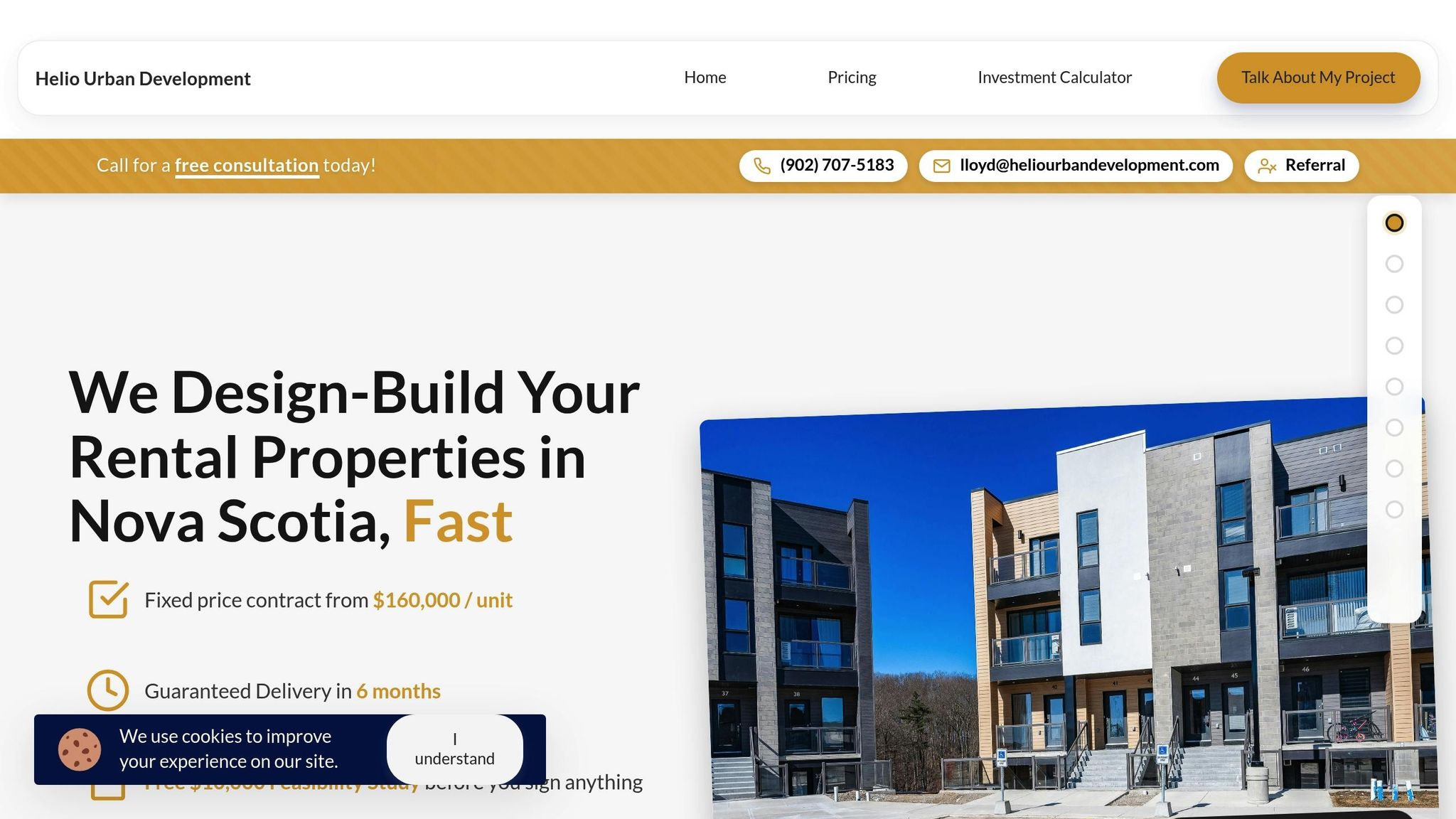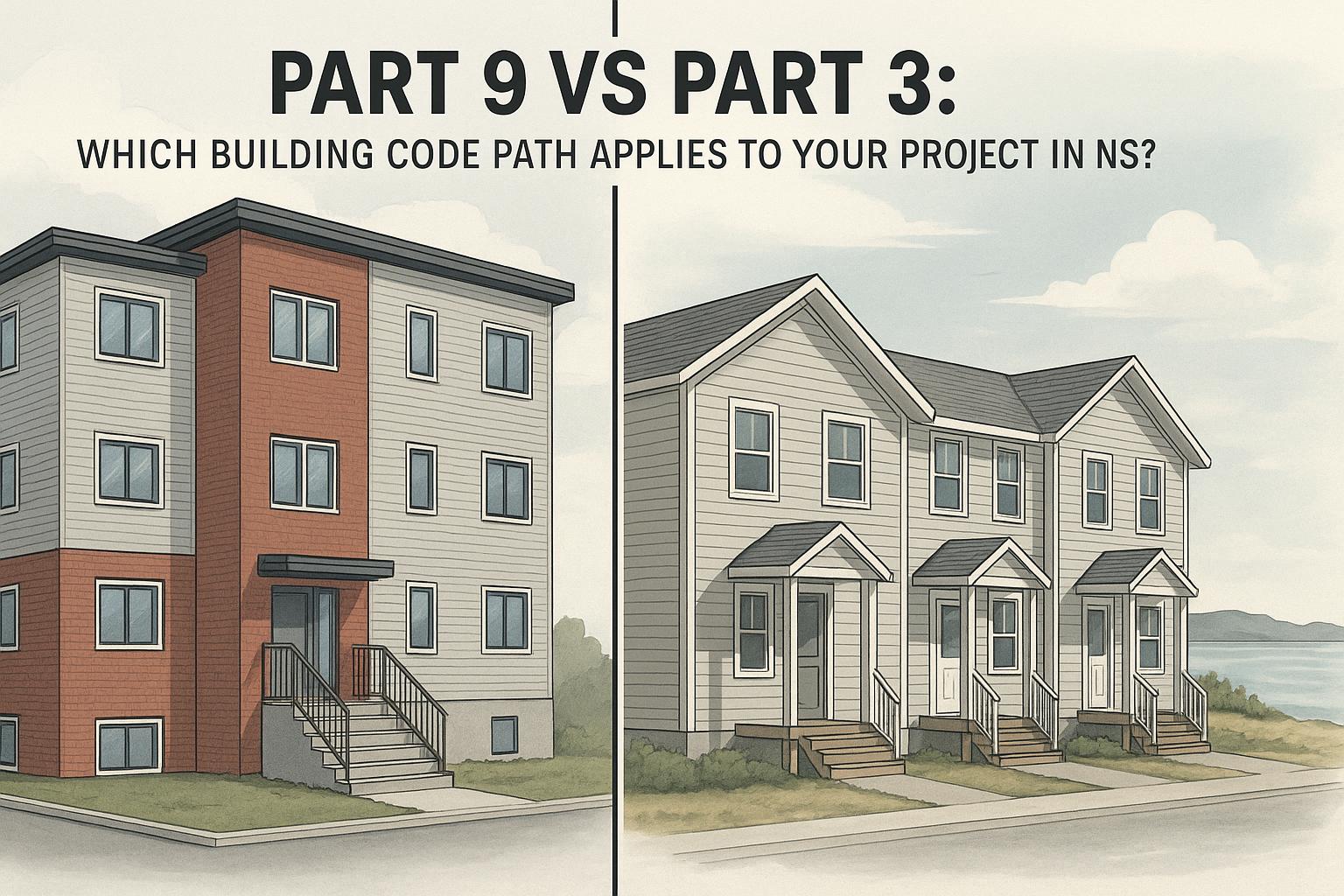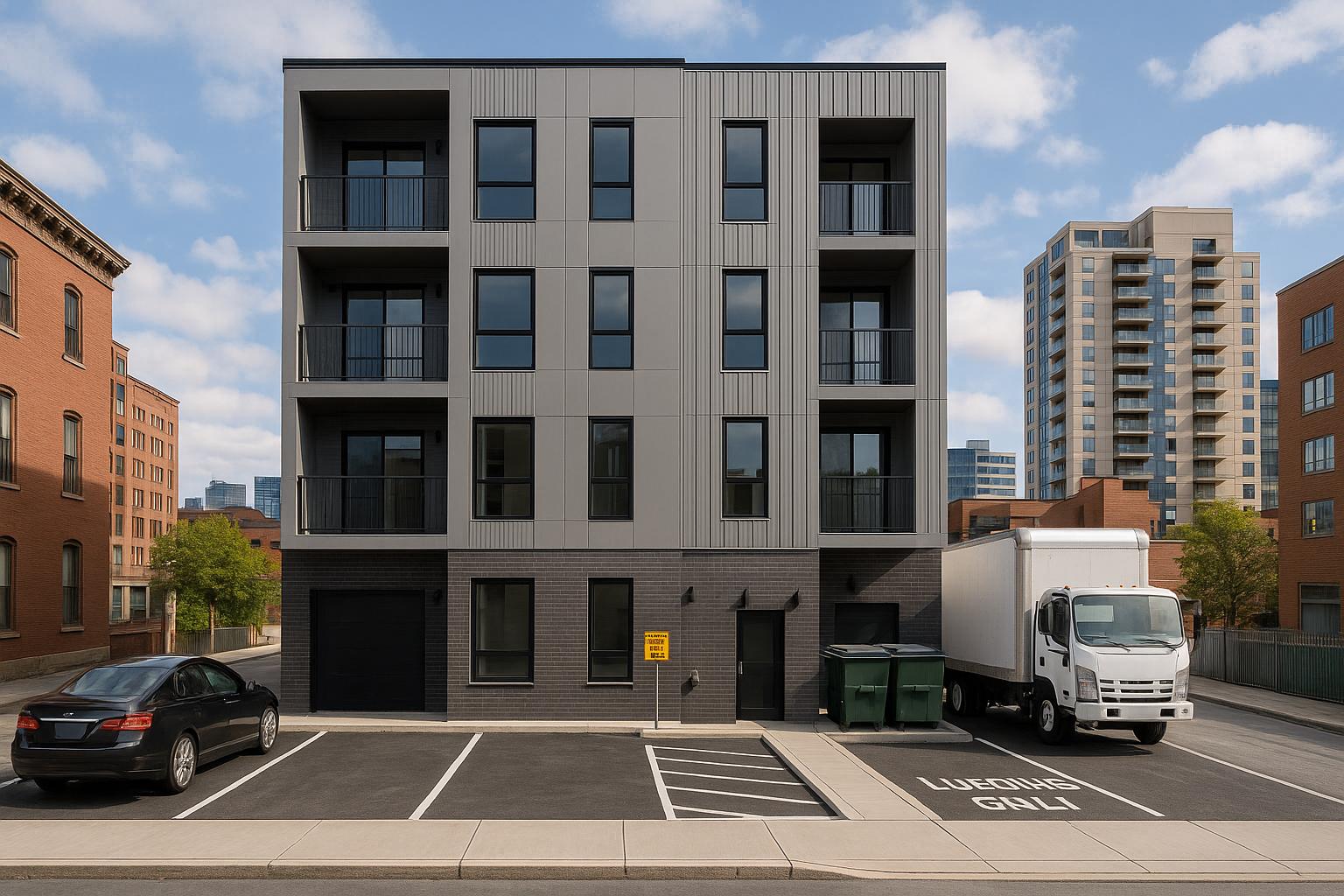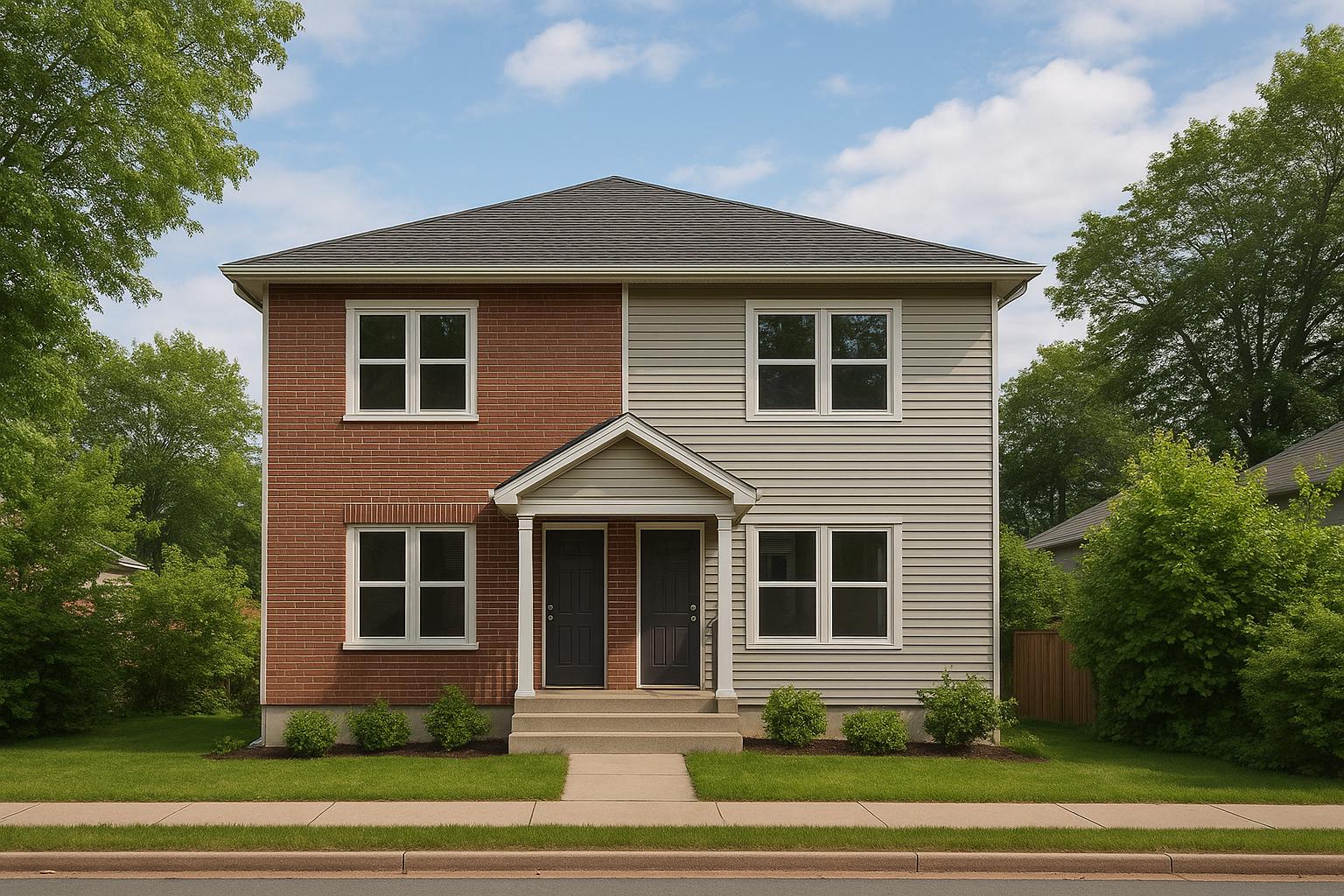Halifax's updated zoning rules make it simpler to add backyard or secondary suites to your property, helping homeowners generate rental income while addressing the city's housing needs. Here's the key takeaway: ER-1 zones allow secondary suites in single-detached homes, while ER-2 zones permit more housing types, like duplexes and backyard suites. These changes eliminate the need for rezoning, speeding up the process.
Quick Facts:
- ER-1 Zones: Single-detached homes with secondary suites.
- ER-2 Zones: Duplexes, semi-detached homes, townhouses, and backyard suites.
- Secondary Suites: Inside the main home, like a basement apartment.
- Backyard Suites: Separate structures, such as a converted garage.
- Size Limit: Suites must be under 90 m².
- Permits: Development and building permits required, typically processed in 30–45 business days.
Why It Matters:
- For Homeowners: Rental income can offset costs like mortgages and taxes.
- For Renters: Adds housing options in established neighbourhoods.
- For Halifax: Supports housing affordability and urban growth.
To build a suite, you’ll need to meet zoning, size, and parking requirements, as well as secure permits and inspections. Builders like Helio Urban Development offer fixed-price contracts ($160,000/unit) and six-month completion guarantees, simplifying the process.
Adding a suite can yield annual returns of 12–20%, with rental rates for two-bedroom suites in Halifax ranging from $1,950 to $2,100/month. Grants up to $12,912.62 are available for qualifying projects. Start your application by June 1, 2026, and complete construction by October 11, 2026, to secure funding.
Halifax’s zoning changes make it easier than ever to boost your property’s value and income potential while contributing to the city’s housing solutions.
What To Consider Before Building Backyard Suites In Halifax
What ER-1 and ER-2 Zones Allow for Backyard and Secondary Suites
ER-1 and ER-2 zoning regulations outline what kinds of accessory rental units homeowners can build. On September 1, 2020, Halifax Regional Council approved changes that expanded opportunities for property owners in most residential zones. These zones include areas where single-detached houses, duplexes, semi-detached homes, and townhouses are permitted [1][2]. These amendments make it easier for homeowners to plan and build suites.
Allowed Unit Types and Lot Requirements
Secondary suites are self-contained living spaces located within the main home. Often called in-law suites or basement apartments, these units must include a private entrance, kitchen, bathroom, and living area. Under the updated rules, secondary suites can be added to single-unit dwellings, duplexes, or townhouse developments.
Backyard suites, on the other hand, are separate structures on the property or converted accessory buildings, like garages. These do not require special exemptions or rezoning - just a standard construction permit. By early 2023, Halifax had issued 398 permits for accessory suites, with 269 for secondary suites and 129 for backyard suites [2].
The type of accessory unit you can build depends on your zoning designation, as explained below.
ER-1 vs ER-2: Main Differences
ER-1 zones are designed for single-detached homes, while ER-2 zones allow for more housing types, such as duplexes, semi-detached houses, and townhouses. This gives property owners in ER-2 zones added flexibility when planning accessory suites.
Real Examples of Backyard and Secondary Suites
By early 2023, 26% of the 398 issued permits were located in the Regional Centre Plan Area, while 17% were in the Halifax Plan Area [2]. These numbers highlight the increasing popularity of accessory suites in Halifax, showcasing their potential as both a housing solution and an investment.
Secondary suites often involve transforming part of the main house - like a basement - into a self-contained living space with its own entrance, kitchen, and bathroom. Backyard suites might include converting a garage or building a new stand-alone unit. For homeowners, these options not only provide a way to generate rental income but also contribute to addressing Halifax’s housing needs.
Requirements for Building Backyard or Secondary Suites
If you're planning to add an accessory suite in Halifax, you'll need to navigate zoning rules, permits, and building codes. Getting familiar with these requirements can save you time and ensure your project stays on track.
Zoning and Building Code Standards
Halifax has specific zoning guidelines for accessory suites. For both secondary and backyard suites, the maximum size is capped at 90 m² (969 ft²). This ensures the suite remains secondary to the main house while offering enough living space.
For backyard suites, height restrictions limit structures to 7.5 m (24.6 ft), which is generally enough for one-and-a-half or two-storey designs. Secondary suites located inside the main home follow the existing height rules for the primary dwelling.
Setback rules - the required distance from property lines - depend on the zone. Typically, backyard suites need to be at least 1.2 m (4 ft) from both side and rear property lines. Parking requirements often call for one additional space per suite, but properties within 400 m of a transit route may qualify for reduced parking obligations.
Backyard suites must also include garbage and recycling screening. The screening structure should be at least 1.2 m (4 ft) tall and made from durable materials that match the main building's style.
All suites must meet standard design criteria, including having separate entrances and fully functional living facilities. Secondary suites specifically need soundproofing to comply with National Building Code standards for noise control.
Permits and Compliance Steps
The process starts with a development permit application through Halifax Regional Municipality. This step ensures your project aligns with zoning rules. Processing typically takes 30 to 45 business days.
Once the development permit is approved, you’ll need a building permit to confirm your plans meet the National Building Code of Canada and provincial standards. This application requires detailed construction drawings, structural calculations, and mechanical/electrical plans prepared by qualified professionals.
A site plan is also essential. It should show the location of the suite, setbacks from property lines, parking spaces, and garbage screening. For secondary suites, floor plans must demonstrate a separate entrance and meet emergency exit (egress) requirements.
Professional input is often needed throughout the process. A licensed designer or architect should handle the drawings, and engineers may need to evaluate structural changes, especially for modifications to an existing home.
The municipality will conduct inspections at key construction stages, such as foundation, framing, insulation, and final occupancy. Each stage must pass inspection before moving forward. With all permits in hand, you can proceed to construction with confidence.
Property Owner Checklist
Before diving into construction, use this checklist to keep everything on track:
- Zoning compliance: Confirm your property is in an eligible zone and meets minimum lot size, setback, and parking requirements.
- Suite details: Ensure your suite doesn’t exceed 90 m² and includes all essentials - separate entrance, full kitchen, bathroom, and proper natural light in living areas.
- Professional team: Hire a licensed designer or architect for drawings and, if needed, engineers for structural work. Verify their credentials in Nova Scotia.
- Budget planning: Account for permit fees, professional services, and any utility upgrades. Development permits typically cost a few hundred dollars, while building permit fees are based on construction value.
- Neighbour relations: While not required, informing your neighbours about your plans can help avoid conflicts and even provide useful feedback about your property.
- Utility capacity: Make sure your electrical, plumbing, and heating systems can handle the added demand.
- Timeline preparation: Allow 60 to 90 days for the permitting process, factoring in potential revisions that could extend the timeline.
Taking care of these details upfront will help you avoid delays and keep your accessory suite project moving smoothly through Halifax's approval process.
sbb-itb-16b8a48
Construction Process and Challenges for Property Owners
Building a backyard or secondary suite in Halifax involves several carefully planned steps. Each stage plays a critical role in ensuring a smoother construction process compared to traditional methods.
Step-by-Step Construction Process
Once permits are secured, the construction begins with site preparation. This might involve excavation or adjustments to existing structures. After that, work moves to the foundation and framing stages. For older properties, additional structural reinforcement may be needed to meet current building codes.
Next, mechanical, electrical, and plumbing systems are installed. At this stage, upgrades like enhancing the electrical panel might be necessary to handle the increased load. The focus then shifts to the interior work, which includes installing insulation, drywall, flooring, fixtures, and finalizing electrical connections.
Throughout the process, Halifax Regional Municipality conducts several inspections to ensure compliance with the Nova Scotia Building Code. Once everything passes, an occupancy permit is issued.
"The new rules mean you or your neighbour can get permission to install a secondary or backyard suite by simply obtaining a permit." - Shape Your City Halifax [1][2]
Challenges with Traditional Construction Methods
Traditional construction methods often bring significant hurdles for property owners. Budget overruns are common, sometimes exceeding estimates by 30–60%. This happens largely because owners must juggle multiple professionals - architects, engineers, electricians, plumbers, and contractors - without a unified project management system.
Delays are another frequent issue. While an ideal timeline might be around eight months, projects can stretch far longer due to weather disruptions, permit revisions, or misaligned schedules among various trades. Quality control is another sticking point. Without a single entity overseeing the project, disputes and inconsistent workmanship can arise, halting progress.
| Fragmented Construction | Integrated Design-Build |
|---|---|
| Multiple contracts with 6+ separate companies | Single contract with one accountable company |
| Cost-plus pricing with frequent overruns | Fixed-price construction with no surprises |
| Typical timelines of 12–18 months | 6-month guaranteed completion |
| Coordination chaos between independent trades | Unified team working toward common goals |
| "Hope for the best" approach to quality control | Systematic quality verification process |
| Property owner manages all disputes | Single point of accountability |
Communication breakdowns are another major challenge. Managing several independent contractors can delay critical decisions, often leading to rework and extra costs. Permit issues may also arise if architectural, engineering, and mechanical plans don’t align perfectly, causing review delays and revisions.
Tips to Avoid Construction Problems
- Hire builders experienced in multi-unit construction: Professionals familiar with rental property requirements - like soundproofing, fire safety, and egress standards - are less likely to make costly mistakes.
- Opt for fixed-price contracts: This ensures contractors provide accurate estimates upfront, reducing the risk of unexpected expenses.
- Demand guaranteed timelines: Insist on a fixed timeline, with penalties (e.g., $1,000 per day) for delays.
- Request daily updates: Use project management tools or photos to track progress and address issues quickly.
- Check credentials: Confirm that architects are licensed by the Nova Scotia Association of Architects and engineers are certified by Professional Engineers Nova Scotia.
- Plan utility upgrades early: Older properties may need updates to water, sewer, or electrical systems to accommodate the new unit.
- Set aside a contingency fund: Even with fixed pricing, having a small reserve for variable fees or utility connections is a smart move.
Helio Urban Development: Solving Construction Challenges

Building backyard or secondary suites in Halifax comes with more than just zoning hurdles. Property owners often find themselves juggling multiple contractors, dealing with unexpected costs, and watching deadlines stretch on indefinitely. Helio Urban Development takes a different approach to rental property construction, aiming to simplify the process and tackle these common frustrations head-on.
Integrated Design-Build Method
Instead of the fragmented construction process that many property owners are used to, Helio streamlines everything by bringing all necessary professionals under one roof. From design to engineering to construction, everything is covered under a single contract. This eliminates the headaches of coordinating between different teams and ensures a smoother process from start to finish.
Helio's founders, Lloyd Liu and Yuan He, bring a wealth of experience to the table. Liu has a background in investment banking and has managed $30 million worth of projects, while He specializes in advanced scheduling systems that help avoid typical project delays. Together, their expertise ensures efficient project execution.
Currently, Helio is managing multiple builds across Nova Scotia, focusing on properties within a 90-minute drive of Halifax. This local focus allows them to offer specialized knowledge and hands-on management for every project.
Features and Benefits for Property Owners
Helio's approach directly addresses the most common pain points in construction. For starters, they offer fixed-price construction at $160,000 per unit, which eliminates the risk of budget overruns that often range from 30% to 60% in traditional projects. Property owners know exactly what they’re paying from the outset.
Another standout feature is their timeline guarantee. Helio promises to complete construction within six months, with financial penalties of up to $1,000 per day if they don’t deliver on time. Compared to the usual 12–18 months that similar projects take, this guarantee provides property owners with much-needed certainty - especially for those eager to start collecting rent.
Here’s a quick breakdown of Helio’s key features and how they benefit property owners:
| Feature | Benefit for Property Owners | Proof of Delivery |
|---|---|---|
| Fixed-price construction | No budget surprises or overruns | $0 in overruns across all projects |
| 6-month guaranteed timeline | Begin earning rental income on time | Up to $1,000/day penalty if late |
| Daily photo updates | Stay informed without site visits | Real-time project portal access |
| Triple quality verification | High construction standards guaranteed | 2-year warranty on all work |
| Single accountability | No disputes between contractors | Zero disputes across 31 units built |
Helio also emphasizes quality control through a triple verification process. A Professional Engineer inspects the work at five key stages, and property owners can hire their own inspector for the final review. This meticulous approach is backed by a two-year warranty on all construction work.
To keep property owners informed, Helio provides daily photo updates through a real-time portal. This transparency eliminates the guesswork and uncertainty that often accompany traditional construction projects.
Why Choose Helio for Your Suite Project
Helio’s integrated method offers property owners a streamlined and dependable construction experience. Specializing in 4+ unit rental properties, they have expertise in ER-1 and ER-2 suite construction. Their builds include features that matter for rental properties, such as ductless heat pumps for energy savings, triple-pane windows for soundproofing, and durable engineered hardwood flooring.
Helio also provides construction tiers tailored to different goals. Their standard option, priced at $160,000 per unit, focuses on maximizing return on investment. Meanwhile, the CMHC MLI Select option, at $200,000 per unit, helps owners secure 95% financing with a 5% down payment. Both options come with high-quality finishes like quartz countertops and custom millwork.
For those who want to start renting immediately, Helio offers a Premium Rental Ready package. This includes Energy Star appliances, smart home technology, and window blinds, saving owners the typical 60-day delay required to furnish units after construction.
With a deep understanding of Nova Scotia’s municipal requirements, building codes, and permit processes, Helio is well-equipped to navigate the challenges of building in the Halifax area. Property owners like Josh Powell and Mandy Brown have faced hurdles such as size restrictions and infrastructure requirements, but Helio’s expertise ensures these obstacles are managed efficiently [3].
Conclusion: Building Profitable ER-1 and ER-2 Suites
Halifax's ER-1 and ER-2 zoning regulations offer a unique opportunity for property owners to expand their rental portfolios, create additional income streams, and increase their property's overall value.
Key Takeaways for Property Owners
Through the Second Unit Incentive Program, property owners can access up to $12,900 in non-repayable grants. For backyard suites, the maximum grant increases slightly to $12,912.62 when both municipal and provincial funding streams are combined [4]. These grants are divided into two main components:
- Water and Wastewater Infrastructure Grant: Provides up to $10,000 to cover new connections.
- Halifax Water Fees Grant: Reimburses up to $2,762.96 - or $2,912.96 for backyard suites - for Regional Development Charges and inspection fees [4].
With rental rates for quality two-bedroom suites in Halifax ranging between $1,950 and $2,100 per month, these projects can generate annual returns of 12–20% while significantly increasing property value. With these financial incentives and potential returns, careful planning is essential to maximize your investment.
Steps to Get Started
To take advantage of the available grants, submit your application by June 1, 2026, and ensure construction is complete with occupancy by October 11, 2026 to meet funding requirements and avoid repayment [4]. Start by confirming your property's zoning through Halifax's online mapping tools or by contacting the planning department. Once eligibility is confirmed, evaluate your lot size, setback requirements, and existing infrastructure to determine the most suitable suite type for your property.
For a seamless process, consider an integrated design-build approach. This method ensures fixed pricing and timely project completion. It’s also wise to plan your financing strategy early. Standard construction financing works for many, but for those seeking greater leverage, CMHC MLI Select financing offers up to 95% financing with just a 5% down payment for energy-efficient builds.
Apply for grants as soon as possible, as the process requires documentation such as proof of property ownership, confirmation of current property tax status, and a valid building permit issued after March 18, 2025 [4]. Keep in mind that these grants are limited to the first secondary unit added to your property.
With Halifax's growing housing demand and supportive municipal policies, now is an excellent time to invest in an ER-1 or ER-2 suite. By following the outlined steps and leveraging the benefits of the design-build approach, you can secure steady rental income and enhance your property's long-term value. Halifax’s current environment makes this a smart move for both immediate returns and future growth.
FAQs
What’s the difference between ER-1 and ER-2 zoning for building backyard or secondary suites in Halifax?
The key distinction between ER-1 zoning and ER-2 zoning lies in how many dwellings you can have on a single property. With ER-1 zoning, you're allowed one primary dwelling and the option to include a secondary suite. This makes it a great choice for areas with lower residential density. On the other hand, ER-2 zoning permits up to two primary dwellings and even allows for a backyard suite, giving property owners more flexibility and the ability to accommodate higher density.
Both zoning options can help generate additional rental income. However, if your goal is to make the most of your property's potential while staying within Halifax’s urban planning guidelines, ER-2 zoning offers more possibilities.
What financial support is available for Halifax property owners looking to build secondary or backyard suites?
Halifax homeowners have access to several financial programs to help with the costs of building secondary or backyard suites. The Halifax Regional Municipality offers the Secondary Suite Incentive Grant, which provides up to $12,900. On top of that, the Nova Scotia government has a forgivable loan program offering up to $40,000, covering 50% of eligible project expenses. For larger projects, the Canada Secondary Suite Loan Program provides loans of up to $80,000 for constructing or renovating these units.
These initiatives aim to ease the financial burden of creating rental units, help homeowners meet local regulations, and increase the income potential of their properties.
What are the advantages of using a design-build approach for building backyard or secondary suites in Halifax?
Using the design-build method for backyard or secondary suites in Halifax comes with several clear benefits. This approach encourages early collaboration between designers, builders, and property owners, allowing potential issues to be addressed right from the start. The result? A smoother decision-making process and fewer surprises along the way.
Another big advantage is the combination of fixed costs and quicker project timelines - often wrapping up within six months. This makes the process more predictable and efficient compared to traditional construction methods. Plus, with Halifax's changing zoning regulations and the increasing need for housing, this method ensures your project stays compliant, stress-free, and financially rewarding.
Related Blog Posts
- Halifax’s New Zoning Rules Explained: Up to Four Units on a Single Lot (What It Means for Builders)
- Secondary Suites and Backyard Homes in Halifax: Adding Value with New Housing Options
- Halifax ER-2 Zoning: Limited to 2 Units Plus Backyard Suite
- Small Halifax Lots Under 375m²: ER-3 Still Allows Secondary Suites



